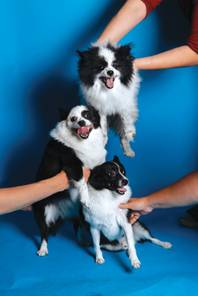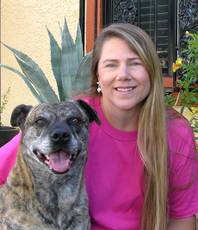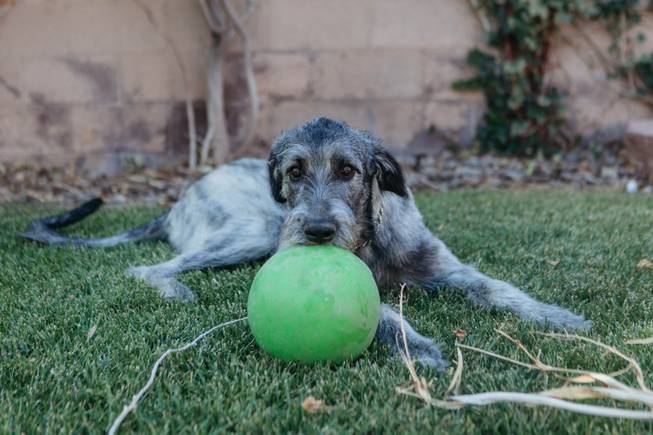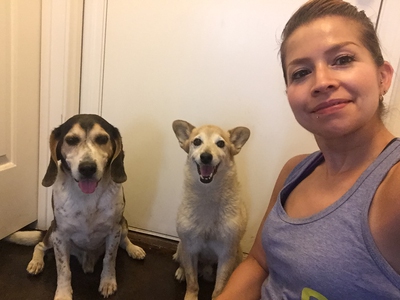Monday, July 25, 2016 | 2 a.m.
The gentle nudge of a paw. A friendly chirp. A boisterous purr. A soul-penetrating gaze.
These are the moments pet owners cherish and cling to, that make messes or misbehavior irrelevant. Because, at the end of the day, we need their love as much as they need ours. But why? Why can animals — whether they’re furry, feathered or scaled — inspire such deep emotion in humans? And how do they maintain such loyalty despite the broken promises to walk them, the late dinners we feed them and the hours we spend venting to them?
Pets in the U.S.
The American Pet Products Association 2015-2016 survey found that 65 percent of U.S. households own a pet.
Scientists call it the human-animal bond, an indisputable phenomenon supported by an ever-growing body of research. The average person might call it unconditional love.
“They’re not judgmental; they’ll listen to us all day,” said Steven Feldman, executive director of the Human Animal Bond Research Initiative Foundation in Washington, D.C. “They’re always happy to see us. … It’s a strong bonded relationship where they really do focus on us and give us everything, which you don’t always get from another person.”
Whatever the nomenclature, this much is true: Animals of all shapes and sizes provide unique benefits to their human companions, prolonging their life spans, improving their moods and helping them navigate challenges. All the more reason to adopt a nonhuman sidekick in need. –Jackie Valley
Need help coping with the loss of an animal?
“The bond that we form with our pets can be very deep and fulfilling, and the loss of a beloved pet can have an impact on us that is as great, or even greater, than the loss of a family member or friend. This bond is what makes our interactions with pets rich and rewarding, but also what makes the grief process so complicated.” That’s wisdom from the Las Vegas Pet Loss Support Group, which meets from 6:30 to 8 p.m. Mondays at Community Lutheran Church, 3720 E. Tropicana Ave. For information, call 702-735-5544 or visit pets702.org.
Detection of Danger Just as dogs can detect drugs and bombs, they can sniff out cancerous tumors. Tumors emit odors known as volatile organic compounds that dogs can pick up in human breath and urine, potentially alerting people to the early stages of the disease. Cancer-sniffing dogs already are assisting researchers in some science and medical laboratories. And more studies examining their cancer-sensing skills are underway around the world.
Emotional Support Whenever there’s a natural disaster or mass-casualty incident, photos usually emerge showing first responders and victims cradling cats and dogs. It’s called pet therapy, based on research that shows the presence of an animal can lower a person’s blood pressure and trigger the release of oxytocin, a hormone that can reduce anxiety and depression. Plus, animals are nonjudgmental, making it easier for people suffering from anxiety, depression or post-traumatic stress disorder to accept their companionship. It’s important to note that while animals can help reduce the symptoms of those medical conditions, they’re not a substitute for proven treatments.
Autism Assistance Autism spectrum disorders often cause social and behavioral challenges that make it difficult for children to connect with other people. However, a study from the University of Queensland in Australia found that animal companionship can unlock social inhibitions in children with autism, making them better at talking, forming bonds and looking people in the eye. A Journal of Pediatric Nursing study surveyed parents of children diagnosed with autism and found that 94 percent of respondents with dogs said their child bonded strongly with the pet. While studies have focused on canine companionship, researchers have suggested other animals may prove better fits for some children.
Health Care Savings Studies have shown that an animal’s presence can yield long-lasting medical benefits for people, improving cardiovascular health, lessening allergies and increasing happiness. Aside from making humans feel better, animals help us save a large chunk of change. Researchers at George Mason University found that pet ownership translates to an estimated $11.7 billion savings in health care costs in the United States every year. The largest cost saving came in the form of doctor visits: Pet owners visited a physician 0.6 times less than others. The amount of time people spent walking their animals — and decreasing their weight as a result — also contributed to reduced health care costs, according to the study.
-

Adventures in Pet Food
The Great Pet Food Recall of 2007 left thousands of dogs and cats dead and people up in arms about how to make pet food safe. Tied to Chinese products tainted with melamine — a cheap, ultimately toxic chemical stand-in for protein — the tragedy shined a light on the industry’s lack of regulation.
In 2011, President Barack Obama signed into law the FDA Food Safety Modernization Act, “the most sweeping reform of our food safety laws in more than 70 years.” Developments that affect pet food continue, but not fast or comprehensive enough for some activists and pet owners. The marketplace has responded in spades.
At the SuperZoo expo happening in early August at Mandalay Bay, many of the new products unveiled will be edible. According to expo organizers, global spending on pet food is about $70 billion annually, $24 billion from the wallets of American consumers. And dog food accounts for 80 percent.
Do you know what your fur baby is eating?
NUTRITION MISSION
For almost a decade, Mike and John Lay have been helping pet owners navigate the flood of food options with Healthy Tails, a Las Vegas offshoot of the Reno store inspired by a “very sick puppy” that vets thought would die before she reached her first birthday. Through special nutrition, Akira Kuna thrived to the age of 12. “Unfortunately, the industry’s not that regulated. So you have to ferret out the guys who are really committed to making better dog food,” Mike Lay says.
He and his brother were customers of Healthy Tails before buying in, and he’s learned a lot about the spectrum of sustenance and the process of transitioning pets — and humans — off what they’ve always known. When he put his own adopted puppy, Apple, on a raw diet, her coat fell out.
“Talk about panic,” Lay says with a chuckle. “It grew back bunny-soft. The wiry coat was from poor nutrition. … Her body was detoxing.”
Raw is just one niche covered at Healthy Tails, which offers freeze-dried and dehydrated options, highly rated wet and dry food and snacks made of everything from crispy fish skins to yak milk. If you have a dog with allergies, Lay says shop staff will take you through history and food routines to send you home with up to five samples so animals can pick their favorites. Of course, there are dogs who’ll eat anything. “If they just Hoover them all up, shop by price. They’re all good foods.”
Rooting out Allergies
Lay says the best way to figure out which foods are inflammatory for your pet is to limit ingredients to just one protein and one or two starches. And if foods with familiar proteins such as beef, chicken and salmon aren’t reducing symptoms, move to “unique” ones like whitefish, duck, kangaroo or rabbit. “They can’t be allergic to something they haven’t had, is the theory.”
Once you’ve experimented with dry foods, you can move to wet or even raw, which Lay says is more easily digestible. “Cooked kibble is not something that would be natural for a dog to eat in the wild, although it can be very nutritious.”
Tip: Secondary ingredients can be allergens, so don’t just pay attention to proteins.
Tip: Don’t mix proteins by adding a chicken treat to a duck-based diet. “If you switch too much at once, then you don’t know what worked and what didn’t.”
Ingredient Guidelines
When shopping for new foods, Healthy Tails recommends careful label reading. Lay’s personal strategy? “Common sense. If you read the ingredients and you’re just confused by what’s in the food, it’s probably not that good for your dog.”
1. Protein source. You want to see words like “lamb” and “chicken,” not “meat” or “poultry,” as you have no idea what you’re getting.
2. Fat. The same goes for labeling of fats. Look for specific meat fats or oils made from fish, nuts or seeds.
3. Byproduct Meal. Lay says this can mean anything from beaks and feathers to bloody sawdust, so it’s an indication of low quality.
4. Carbohydrates. You want wholesome grains like oatmeal, rice, barley or millet, and for grain-sensitive pets, peas, lentils and potatoes. Avoid corn, wheat and soy, as they are “top allergens, top fillers.”
5. Chemicals. Lay warns against preservatives like BHA and BHT, as some studies suggest they might be carcinogens. And while artificial colors and flavors might be harmless, he says, “It’s all stuff that’s unnatural to a dog. Propylene glycol? You don’t want to see that.”
6. “Animal digest.” According to Lay, this is a tripe spray applied to food to entice dogs to eat it no matter what it is. He advises steering clear of products that contain it.
Raw Trend
“It’s a very popular diet, but the biggest drawback is cost,” Lay says of feeding pets raw meats mixed with produce and supplements. Primal — the brand that helped save Akira Kuna — is generally about 80-20 in percentages of protein to produce and supplements in “complete and balanced” frozen patties thawed to serve. For a 70-pound dog, it costs about $350 a month. Lay says the price of wet food is comparable, and you can cut the cost with The Honest Kitchen dehydrated premixes or alternating meals with dry kibble.
It's important to do your research and talk with your vet about the possibilities. But to those who wonder about the safety of raw products, Lay says the chicken used for the raw food he sells is better quality than what humans buy from the average grocery store in the likelihood of salmonella contamination. “They know you’re going to cook it,” he says, adding that the reason pet foods are recalled for salmonella outbreaks is to minimize risks of animals spreading the bacteria to humans. He recommends reading up at Whole Dog Journal.
Picking the Right One
Don’t assume the most expensive food is the best for your pet. Lay sells an 11-pound bag of air-dried venison by ZiwiPeak that’s over $200, as well as a 35-pounder of Premium Edge kibble for $36. “If your dog does really well on that $36 bag, that’s the best dog food in the store,” he says. Choosing a product is about your pet’s sensitivities and your budget. Lay recommends sites like Dog Food Advisor for reviews, but some of his favorite brands include: Petcurean, Orijen, Weruva and Annamaet. That last one was developed by a sled-dog racer. “I like the ones that are not just good-quality foods, but that are about the dogs,” Lay says.
Tip: You know that idea about kibble “brushing” a dog’s choppers to keep them clean and healthy? “That’s like us eating a pretzel to clean our teeth.”
Healthy Tails 8457 W. Lake Mead Blvd., 702-656-1700.
• • •
EXPLORING HOMEMADE
When Marlyn Granados inherited her dad’s dogs, Bagel and Sparky, they were like an extension of him — with more ear scratching, paw biting and general allergy-related misery. Granados said they were on medications to control the symptoms. But she had changed her own health through food, from weight and skin problems to stomach issues, and she thought it might work for her fur babies.
“I became obsessed with reading up on dog food,” Granados says. And the more she read, the more she found evidence that “real” food could be beneficial for dogs. She put bits of carrot and banana in their dry food, slowly getting more adventurous and changing their diet to 30 percent high-quality kibble (she uses Spot’s Stew by holistic brand Halo) and 70 percent cooked meats, grains and vegetables fortified with vitamin powder and local honey.
“The ear infections were less frequent, the itching stopped and their coats started to shine like never before. They didn’t need their prescriptions anymore,” says Granados, who was empowered by the fact that her grandparents in Mexico fed their working ranch dogs nothing but table scraps. “It’s not for everybody, and that’s OK. But whoever’s open to it, I love talking to people about it,” she says. “I don’t ever call myself a professional, I just call myself a common-sense person.”
Granados says this because her results with Bagel and Sparky led to Fido’s Fine Dining, a year-old boutique business she’s taking from her farmers market routine to a storefront on West Sahara and Buffalo in September. Her recipes range from salmon with quinoa and green beans to lamb with cauliflower and blueberries. It’s $5 for an 11-ounce bag, and treats like duck jerky or pumpkin-flavored allergy balls are $5-$7 a pack. She laughs and says that if you open her refrigerator at home, it is wall-to-wall dog food, so she’s thrilled to be moving into a commercial kitchen. Not just for her husband's sake — because she loves sharing her experience.
“I share all my recipes. I would love for people, if they can’t buy it right now, just to go home and cook for their dog a little bit,” Granados says. “You start to see what works best with their body, with their chemistry, with their energy level. … It’s just being in tune with your dog.”
Tip: Granados says that the more unprocessed the food, the smaller the poop, as pets digest more material and absorb more nutrients.
Find Fido’s Wednesdays at Bruce Trent Park, 4-8 p.m.; Thursdays at The District (spring/fall), 4-8 p.m.; Saturdays at Downtown Summerlin, 9 a.m.-2 p.m.; Sundays at Fresh52 in Henderson, 8:30 a.m.-1 p.m.
Fido’s Fine Dining Beef Stew
Note: Consult your veterinarian before feeding your dog homemade food.
Calories: 450
Method: In a pan on the stove, cook meat to 165 degrees. Boil peas and carrots until soft. Cook brown rice. Mix together and add coconut oil. Let cool and serve. Option: Add a vitamin supplement like Dinovite or Balance It, found online or in many pet stores.
Benefits: Granados points to the good natural fat in the beef, the nutrients in the vegetables, and the filling quality of brown rice to help manage weight.
-

Siblings Melon and Mango are up for adoption! Contact the Animal Foundation at 702-384-3333 x131. Be sure to provide the number of the kitten you’re inquiring about.
Groom Like a Pro
BATHING
For Cats
How often: As needed. Most cats hate baths. Thankfully for everyone involved, bathing isn’t necessary unless the cat gets particularly dirty, suffers from allergies or has a greasy coat.
1. Wear long sleeves to protect yourself from claws. And attempt a bath when the cat is mellow, such as after a long play session.
2. In a large sink using lukewarm water, wet the cat thoroughly using a hand-held spray hose or pitcher, taking care to avoid ears, eyes and nose.
3. Gently massage the cat with cat shampoo, working from head to tail in the direction of the hair growth. Do not shampoo the face or ears.
4. Thoroughly rinse off the shampoo. Residue can irritate skin and attract dirt.
5. Use a washcloth and water — not shampoo — to wipe the cat’s face.
6. Pat the cat dry in a towel. If he or she has long hair, detangle it with a wide-toothed comb.
For Dogs
How often: Once a month. Dogs roll, lick and chew on their fur to keep clean, which means frequent baths typically aren’t necessary. In fact, bathing a dog too often can dry out its skin and cause more harm than good.
1. Use a spray hose or pitcher to wet the dog thoroughly. Bathing a dog outdoors can reduce the possibility of a mess (they shake!), but bathtubs or showers work fine as well. Do not pour water directly in the dog’s ears, eyes or nose.
2. Massage in canine shampoo, working from the dog’s head to tail, then rinse thoroughly. Tip: If you run out of dog shampoo, use baby shampoo instead. Dogs with loose facial skin or wrinkles need special attention. Clean the folds using damp cotton balls, and be sure to dry the creases thoroughly to prevent irritation or infection.
3. Rub the dog dry with a large towel.
BRUSHING
For Cats
How often: 1-2 times per week. Brushing not only helps remove dirt, grease and dead hair from a cat’s coat, it removes dandruff and stimulates circulation.
For short-haired cats: Use a metal comb or rubber brush to brush the cat’s fur from head to tail, including its chest and abdomen. Brush in the direction the coat grows, focusing on one area at a time.
For long-haired cats: Start with the cat’s abdomen and legs, gently combing the fur upward toward the cat’s head. Then comb the neck fur upward toward the cat’s chin. Make a part down the middle of the cat’s tail and gently brush outward on both sides. If needed, use scissors to snip off feces-matted fur. Tip: Sprinkle talcum powder over knots to help detangle them, using your fingers to gently tease the hair apart.
For Dogs
Regular brushing can reduce significantly the amount of shedding plaguing your clothes and furniture. Brushing also helps distribute natural oils in a dog’s fur and skin to keep the coat healthy and looking great.
For smooth, short coats:
How often: Once a week. Use a rubber brush to loosen dead skin and dirt, then follow with a bristle brush to remove dead hair. If desired, polish the dog’s coat with a chamois cloth.
For short, dense fur:
How often: Once a week. Use a slicker brush to remove tangles, then catch dead hair with a bristle brush. Don’t forget the tail.
For long, silky coats that get matted:
How often: Daily. Remove tangles with a slicker brush, then follow with a bristle brush. Trim hair around the feet. Tease out tangles with a slicker brush, then follow with a bristle brush. Clip any densely matted areas.
NAILS
For Cats
How often: Every 10 days to 2 weeks. Did you know cats’ nails should be trimmed? Feline nails grow in layers, and scratching alone doesn’t remove the older shells that form. Trimming can prevent ingrown nails, can improve bonding (as scratches won’t be as painful) and be an effective alternative to declawing.
1. Sit the cat on your lap, facing away from you, in a quiet room when the cat is relaxed or sleepy. Hold one paw between your fingers and massage it for one to two seconds.
2. Gently press the cat’s toe pad so the nail extends. Using human nail clippers, trim only the sharp tip of the nail, then release the cat’s toe. Be sure to trim only the white part of the claw. The pink part, called the quick, is extremely sensitive because it contains nerves and blood vessels. If you accidentally cut the quick, it will bleed; stop the bleeding by patting the end of the claw with styptic powder or cornstarch.
For Dogs
How often: Trim when nails touch the ground. This could be weekly for leisurely pets or monthly for dogs who spend lots of time outdoors. Concrete and other hard surfaces naturally file dogs’ nails.
1. With the dog lying on its side, hold the paw firmly but gently. Start with the back feet, and use a nail trimmer specifically designed for dogs.
2. Cut from top to bottom at a slight angle to maintain the natural curvature of the nail.Cut only a small bit of nail until you see a faint circle appear on the cut surface. The circle indicates you are nearing the quick. Use an emery board to smooth any rough edges.
EARS
How often: As needed, but generally every couple of weeks to a month. Healthy feline ears are pale pink and have no debris, odor, earwax or bald spots. Healthy canine ears are pink with a light coating of pale yellow wax and no odor.
1. Place liquid ear cleaner (ask your vet for a recommendation) onto a clean cotton ball or piece of gauze. Tip: If you don’t have special cleaner on hand, use mineral oil or hydrogen peroxide to clean a dog’s ears.
2. Fold the pet’s ear back gently, and wipe away any debris or earwax you see. Lift away the dirt and wax rather than rub it into the ear. Never clean the pet’s ear canal; probing can cause trauma or infection.
EYES
How often: As needed, possibly daily. Both dogs’ and cats’ eyes should be clear and bright, and the membrane around the eyeball should be white. Pupils should be equal in size, and the pet’s lower eyelids should be pink, not red or white.
1. Wipe away any crust or gunk with a damp cotton ball. Always begin at the corner of the eye, and use a fresh cotton ball for each eye. Do not use eyewashes or eyedrops unless they’ve been prescribed by your vet.
2. Snip away long hairs that could block the pet’s vision or poke its eyes.
TEETH
How often: 2-3 times a week. Bacteria and plaque-forming foods can build up on a pet’s teeth and harden into tartar, potentially causing gingivitis, receding gums and tooth loss. Regular brushing and chew toys can keep dental disease at bay.
1. Use a toothbrush and toothpaste designed specifically for dogs or cats. Place the brush at a 45-degree angle to the teeth.
2. Use small, circular motions to brush the pet’s teeth, focusing on one area at a time. Lift the pet’s lips as necessary.
-

Toby Tiger and Stacy
Las Vegas Pet Scene Magazine
When Stacy Rombach lost her dog Darby to valley fever, a fungal infection she’d never heard of, she decided to share the painful lesson. Not just with friends and family who knew the dog, but with every person who saw her face on the cover of the first Las Vegas Pet Scene Magazine. That run was 5,000 copies distributed only at vets and indie pet stores. Now, the free publication prints more than 30,000 copies every other month, and delivers to more than 350 Southern Nevada locations.
Rescue Efforts
According to the American Society for the Prevention of Cruelty to Animals, about 7.6 million companion animals enter about 13,600 independent animal shelters nationwide every year. About 3.9 million are dogs and 3.4 million are cats. Of the total, 2.7 million animals are euthanized, and 2.7 million are adopted. The database compiled by Las Vegas Pet Scene Magazine shows that Southern Nevada’s animal-welfare landscape includes rescues for dogs, cats, horses, birds, rabbits, ferrets, pigs, reptiles and rodents.
It covers dogs, cats, birds, reptiles, horses, fish and exotics, with topics ranging from health, recreation and lifestyle to anything related to animal welfare. The writers are volunteers who support the mission, and from the endless adorable pet photos posted for themed contests, it’s clear LVPS has an energetic following.
When Rombach and her business partner founded the magazine five years ago, they aimed to “connect the pet community” and offer as much information as possible to help pet owners and organizations caring for animals without homes. She says overpopulation is a huge issue in Southern Nevada. “I don’t think people realize how big the rescue community is here in Las Vegas, and how much people are doing every day to help those pets.”
Her dog, Toby Tiger, is a “foster fail” who came into her life when she was trying to get over the heartbreak of Darby. “I called up a rescue and I said, ‘Just give me a dog who needs a home. You pick.’” The 100-pound Mountain Cur has struggled with aggressive behavior, Rombach working tirelessly over the past three years to get him socialized. Toby might not be ready to run wild at one of the dog parks on LVPS' comprehensive map, but his person is committed to the journey. “Pets do grip your heart," she said, "and they don’t let go.”
After 25 years of being an animal lover in Las Vegas, Rombach has observed some of the big issues in the local pet scene:
Overpopulation. Thanks to backyard breeders and a lack of spaying and neutering, many animals across many breeds are in need of homes, or fosters to relieve the pressure on local shelters. “A lot of people call us thinking we’re a rescue, and they’re like, 'I need help! I can’t take care of my dog or my cat or my pig or my bird,' and it’s so hard to take those phone calls and direct them on where to go, because we do have so many unwanted pets that people can no longer care for, and the rescues already have a lot in foster. ... Every time they adopt a pet out, they have five waiting for that spot."
Neglect. This can be anything from underfeeding (or not feeding) animals to keeping them tethered, which Rombach says has many adverse side effects. Advocates will soon go before Clark County Commission’s Animal Advisory Board to propose an anti-tethering law intended for statewide application.
Coyotes. The farther into the wilderness the valley creeps, the more interaction with coyotes, who are getting bolder about killing small dogs, cats and pet rodents even when they’re behind backyard fences.
Heat. It should be obvious that pets need plenty of water and shade, and that they shouldn't be left in vehicles. Rombach says that no matter the temperature, Nevada law forbids it.
-

Tortoises Need Love, Too
When Kobbe Shaw was helping rescue desert tortoises from a hoarding situation, one crawled over to him, climbed atop his leather dress shoes and pooped.
“She kind of picked me,” he said. “You know what I mean?”
What may have horrified most people endeared Shaw, and he wound up adopting the young desert tortoise, now named Heidi. She’s one of the fortunate few. Earlier this month, 134 desert tortoises in Clark County needed new homes, but only 25 potential “custodians” had stepped forward to adopt, said Shaw, executive director of the nonprofit Tortoise Group.
The U.S. Fish and Wildlife Service lists the Mojave desert tortoise as a “threatened” species, meaning it’s illegal to catch, buy or sell them; however, it’s legal to keep desert tortoises acquired before Aug. 4, 1989, and their offspring. Captive desert tortoises are ill-equipped to be reintroduced to the wild, partly because many have a respiratory disease that weakens their immune systems if unable to access stable food and water, Shaw said.
Nevada law also stipulates that desert tortoises can’t be transported across state lines, so if a custodian — a person who legally possesses the reptile — moves, the tortoise must stay. That’s where the Tortoise Group comes in: The advocacy and rescue organization finds homes for abandoned, unwanted or found captive desert tortoises.
“We have way, way too much supply and not enough demand,” Shaw said.
He estimates there are roughly 40,000 captive desert tortoises living in Clark County. The Tortoise Group receives at least one call each day about a hard-shelled reptile found wandering suburban streets or in need of a new home.
Ask Shaw why they make great pets, and he rattles off a list of positive attributes: They sleep six months out the year and are low-maintenance, relatively cheap to feed and full of personality. Heidi, who is actually pretty shy, emerges from her burrow when she hears Shaw’s voice — just like any more conventional pet. Plus, captive tortoises can live to be 100 years old. “I can’t tell you how many people say, ‘I want an animal that’s not going to die on me,’” he said.
Want to adopt? Contact the Tortoise Group at 702-739-7113 or visit tortoisegroup.org. There’s a $75 adoption fee, and potential custodians will receive a yard consultation first to ensure the habitat is safe and healthy.
-

Hauspanther's CATchall
Hot New Products Headed to SuperZoo
We spoil them, obsess over their safety and try to teach them a thing or two. Our pets are our babies, and it’s our way of showing them love.
Capitalism has caught on in the world of pet care — and not disappointed. The American Pet Products Association projects Americans will spend close to $63 billion on our animals this year, compared with $21 billion a decade ago. (You probably didn’t know you needed bacon bubbles until you saw them.)
SuperZoo, the national trade show for pet retailers, rolls into Las Vegas next week for its annual conference, bringing with it oodles of new products. Here are our favorites:
Gloture by Lavish Pets
Tired of taking Fido on walks in the day’s heat? Lavish Pets has unveiled a line of glow-in-the-dark clothing for your furry sidekick — perfect for nighttime jaunts. Elly Kaye, the company founder and CEO, created the Gloture line to increase safety and visibility when animals are outside at night. The line includes a reversible dog coat ($150), a princess dog dress ($275) and collar and cuffs with a satin bowtie and Swarovski crystals ($150). lavishpets.com
E-Z PASS Pet Door by Ideal Pet Products
Consider it the 21st-century doggy door. E-Z PASS is a radio-frequency controlled pet door to keep out unwanted pests and wild animals, increasing safety in the process. It works when a small key fob is attached to a dog’s or cat’s collar. The 7-by-9-inch door features a clear flap made of unbreakable plastic and can accommodate animals weighing as much as 25 pounds. It will be available in late summer or early fall, but a price has not yet been released. idealpetproducts.com
The Hauspanther Collection by Primetime Petz
Traditional scratching posts aren’t exactly chic decor. A new line of designer cat furniture aims to please both your feline and your style preferences. The pieces — designed by Kate Benjamin, who runs an “online magazine for design-conscious cat people” called Hauspanther — are sleek and mod. Options include the Cubitat (a bed and hideaway), the CATchall (a scratcher, perch and storage unit), the Next Perch (a perch and lounge) and the Step Perch (a perch, scratcher and lounge). primetimepetz.com
Mini AC Hounditioner by Akoma Dog Products Inc.
When triple-digit heat bears down upon the Las Vegas Valley, it’s not just humans who run for shade or air conditioning. Animals suffer in scorching temperatures as well, but fear not: The Hounditioner can soothe your hot canine. The small air-conditioning unit, which sits inside or attaches to the outside of a dog house, provides a steady flow of recirculated, refrigerated air to keep animals comfortable amid brutal heat. houndheater.com
Dog Goggles by Rex Specs
This eyewear won’t just make your pooch look cool — it also will protect his vision. Rex Specs Dog Goggles were designed to help dogs with eye conditions linked to ultraviolet light exposure. The goggles, with a strap allowing full jaw motion, are becoming increasingly popular among owners of hunting and law enforcement dogs who need eye protection. If your dog dons Rex Specs, just prepare for extra attention. $79.95, rexspecs.com








Join the Discussion:
Check this out for a full explanation of our conversion to the LiveFyre commenting system and instructions on how to sign up for an account.
Full comments policy